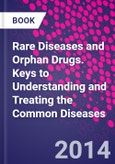Rare Diseases and Orphan Drugs shows that much of what we now know about common diseases has been achieved by studying rare diseases. It proposes that future advances in the prevention, diagnosis, and treatment of common diseases will come as a consequence of our accelerating progress in the field of rare diseases.
Understanding the complex steps in the development of common diseases, such as cancer, cardiovascular disease, and metabolic diseases, has proven a difficult problem. Rare diseases, however, are often caused by aberrations of a single gene. In rare diseases, we may study how specific genetic defects can trigger a series of events that lead to the expression of a particular disease. Often, the disease process manifested in a certain rare disease is strikingly similar to the disease process observed in a common disease.
This work ties the lessons learned about rare diseases to our understanding of common ones. Chapters covering the number of common diseases are minimized, while rare diseases are introduced as single diseases or as members of diseases classes. After reading this book, readers will appreciate how further research into the rare diseases may lead to new methods for preventing, diagnosing, and treating all diseases, rare or common.
Please Note: This is an On Demand product, delivery may take up to 11 working days after payment has been received.
Table of Contents
PART I Understanding the Problem 1. What are the Rare Diseases, and Why Do We Care? 2. What are the Common Diseases? 3. Six Observations to Ponder While Reading This Book
PART II Rare Lessons for Common Diseases 4. Aging 5. Diseases of the Heart and Vessels 6. Infectious Diseases And Immune Deficiencies 7. Diseases of Immunity 8. Cancer
PART III Fundamental Relationships between Rare and Common Diseases 9. Causation And the Limits of Modern Genetics 10. Pathogenesis; Causation's Shadow 11. Rare Diseases and Common Diseases: Understanding Their Fundamental Differences 12. Rare Diseases and Common Diseases: Understanding Their Relationships 13. Shared Benefits 14. Conclusion
Appendix I List of Genes Causing More Than One Disease II Rules, Some of Which are Always True, and All of Which are Sometimes True








